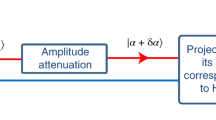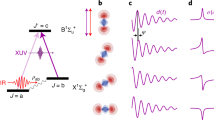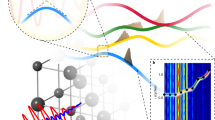Abstract
The threshold condition for laser action is usually achieved when the population difference between the initial and final energy levels of the laser transition reaches a critical value, determined by the equality between optical gain and losses. But the threshold condition can also be achieved by increasing the oscillator strength of the laser transition itself, while the population difference is held constant. This forms the basis of a new class of semiconductor lasers, a notable feature of which is broad wavelength tunability (on application of an electric field) in the technologically important mid-infrared region of the spectrum.
This is a preview of subscription content, access via your institution
Access options
Subscribe to this journal
Receive 51 print issues and online access
$199.00 per year
only $3.90 per issue
Buy this article
- Purchase on Springer Link
- Instant access to full article PDF
Prices may be subject to local taxes which are calculated during checkout






Similar content being viewed by others
References
Weisbuch, C. & Vinter, B. Quantum Semiconductor Structures(Academic, San Diego, (1991)).
Liu, H. C., Levine, B. F. & Anderson, J. Y. Quantum Well Intersubband Transitions: Physics and Devices(NATO ASI Ser. E, Vol. 270, Plenum, New York, (1994)).
Rosencher, E., Vinter, B. & Levine, B. F. (eds) Intersubband Transitions in Quantum Wells(NATO ASI Ser. B, Vol. 288, Plenum, New York, (1992)).
Ando, T., Fowler, A. B. & Stern, F. Electronic properties of two-dimensional systems. Rev. Mod. Phys. 54, 437–672 (1982).
Capasso, F., Faist, J. & Sirtori, C. Mesoscopic phenomena in semiconductor nanostructures by quantum design. J. Math. Phys. 37, 4775–4792 (1996).
Faist, J. et al. Quantum cascade laser. Science 264, 553–556 (1994).
Faist, J. et al. Vertical transition quantum cascade laser with Bragg confined excited state. Appl. Phys. Lett. 66, 538–540 (1995).
Sirtori, C. et al. Long wavelength (λ ∼ 11μm) quantum cascade lasers. Appl. Phys. Lett. 69, 2810–2812 (1996).
Sirtori, C. et al. Mid-infrared (8.5μm) semiconductor laser operating at room temperature. IEEE Photon. Technol. Lett. 9, 294–297 (1997).
Faist, J. et al. High power mid-infrared (λ ∼ 5μm) quantum cascade lasers operating above room temperature. Appl. Phys. Lett. 68, 3680–3682 (1996).
Faist, J. et al. Quantum cascade lasers without intersubband population inversion. Phys. Rev. Lett. 76, 411–414 (1996).
Harris, S. E. Lasers without inversion: interference of lifetime-broadened resonances. Phys. Rev. Lett. 62, 1033–1036 (1989).
Imamoglu, A. & Ram, R. J. Semiconductor lasers without population inversion. Opt. Lett. 19, 1744–1746 (1994).
Sargent, M., Scully, M. O. & Lamb, W. E. Laser Physics(Addison Wesley, New York, (1977)).
Kazarinov, R. F. & Suris, R. A. Electric and electromagnetic properties of semiconductors with a superlattice. Fiz. Tekh. Poluprov. 6, 148–159 (1972); transl. in Sov. Phys. Semicond. 6, 120–131 (1972).
Keay, B. J. et al. Photon-assisted electric field domains and multiphoton-assisted tunneling in semiconductor superlattices. Phys. Rev. Lett. 75, 4098–4101 (1995).
Faist, J. et al. Mid-infrared field-tunable intersubband electroluminescence at room temperature by photon-assisted tunneling in coupled-quantum wells. Appl. Phys. Lett. 64, 1144–1146 (1994).
Caine, E. J., Subbanna, S., Kroemer, H., Merz, J. L. & Cho, A. Y. Staggered-lineup heterojunctions as sources of tunable below-gap radiation: Experimental verification. Appl. Phys. Lett. 45, 1123–1125 (1984).
Oberli, D. Y. et al. Direct measurement of resonant and nonresonant tunneling times in asymmetric coupled quantum wells. Phys. Rev. B 40, 3028–3031 (1989).
Sirtori, C., Capasso, F., Faist, J. & Scandolo, S. Nonparabolicity and a sum rule associated with bound-to-bound and bound-to-continuum intersubband transitions in quantum wells. Phys. Rev. B 50, 8663–8674 (1994).
Price, P. J. Electron transport in polar heterolayers. Surf. Sci. 113, 199–210 (1982).
Faist, J. et al. Continuous wave operation of quantum cascade lasers based on vertical transitions at λ = 4.6μm. Superlattice Microstructures 19, 337–345 (1996).
Martinelli, R. U. Mid-infrared wavelengths enhance trace-gas sensing. Laser Focus World 32, 77–81 (1996).
Tacke, M. New developments and applications of tunable IR lead salt lasers. Infrared Phys. Technol. 36, 447–463 (1995).
Acknowledgements
We thank S. N. G. Chu for transmission electron microscopy work on some of the structures, and C. Gmachl for discussions.
Author information
Authors and Affiliations
Corresponding author
Rights and permissions
About this article
Cite this article
Faist, J., Capasso, F., Sirtori, C. et al. Laser action by tuning the oscillator strength. Nature 387, 777–782 (1997). https://doi.org/10.1038/42872
Received:
Accepted:
Issue Date:
DOI: https://doi.org/10.1038/42872
This article is cited by
-
Mid-infrared frequency comb based on a quantum cascade laser
Nature (2012)
-
A 1.8-THz quantum cascade laser operating significantly above the temperature of ℏω/kB
Nature Physics (2011)
-
A multiwavelength semiconductor laser
Nature (1998)
Comments
By submitting a comment you agree to abide by our Terms and Community Guidelines. If you find something abusive or that does not comply with our terms or guidelines please flag it as inappropriate.



